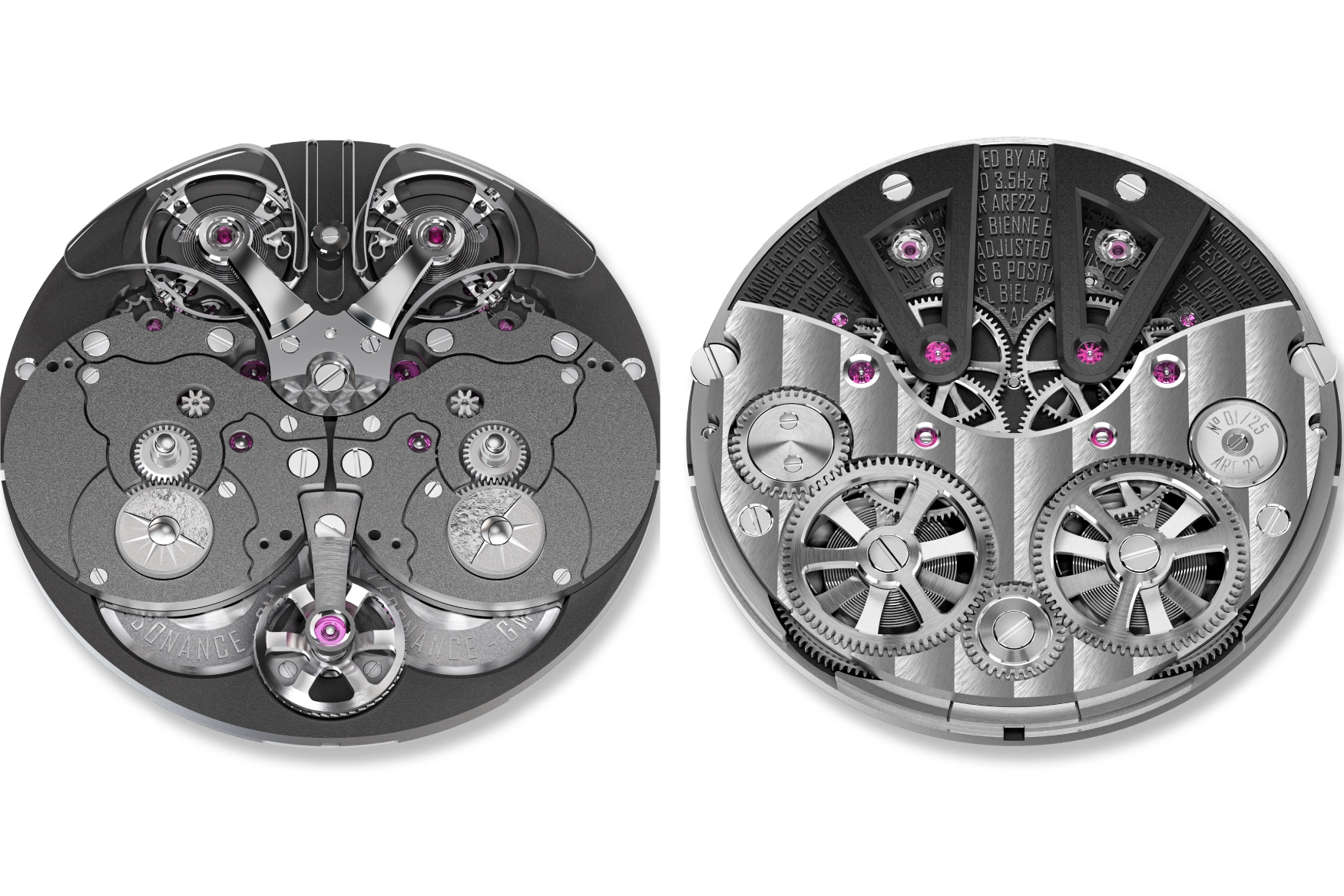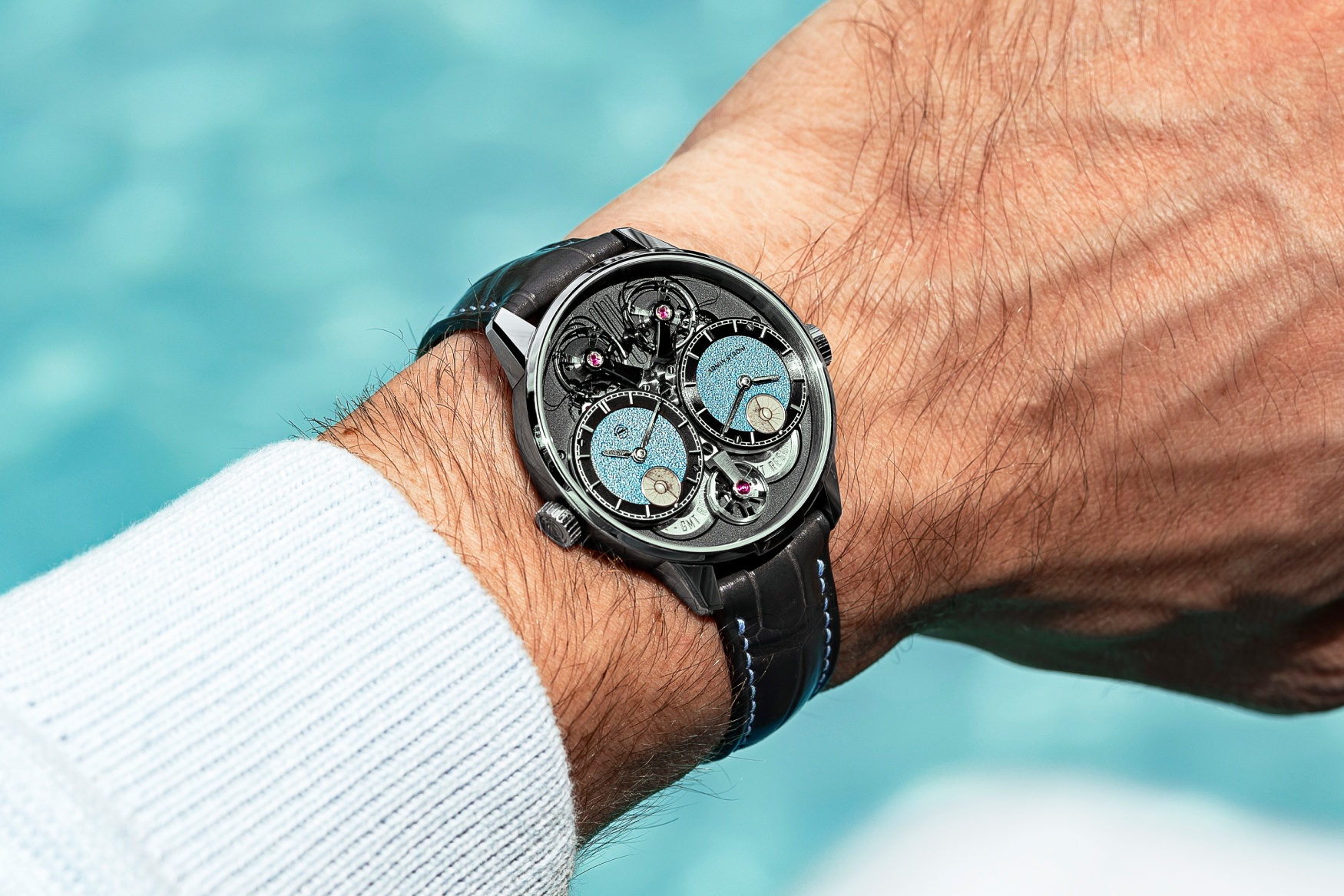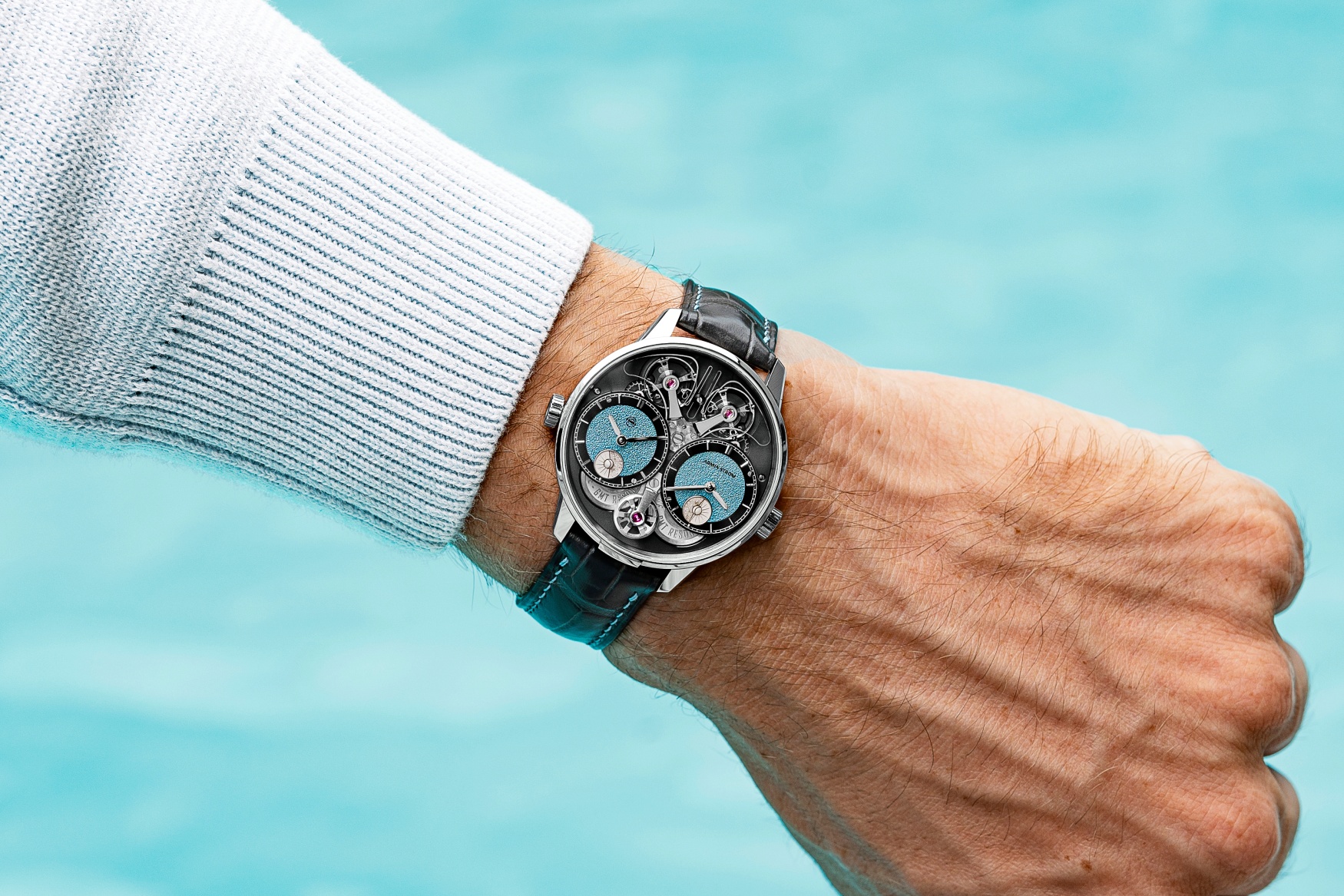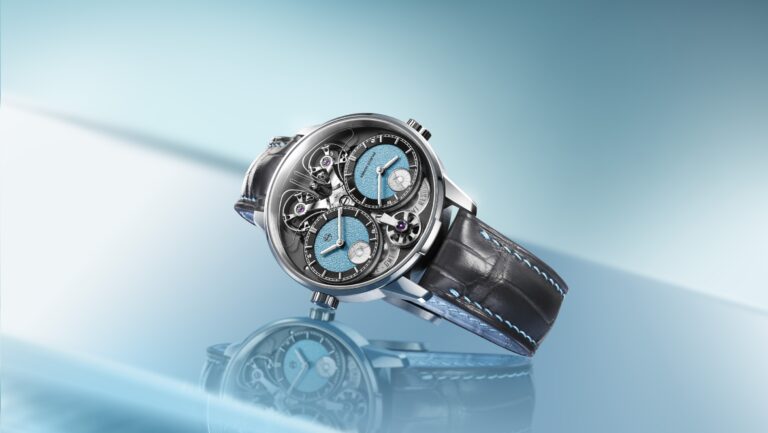Borna Bošnjak The Dual Time GMT Resonance with a 39mm white gold case is Armin Strom’s smallest resonance watch to date. The new ARF22 caliber with a vertically arranged gear train fully unleashes the brand’s patented resonance solution. This first edition model is limited to 25 pieces and is priced at US$120,700.
When you think of the most impressive complications a watch can have, you think of repeaters, tourbillons, perpetual calendars, and perhaps split-second chronographs. While these complications remain challenging to achieve, they are becoming more and more common, especially when it comes to affordable tourbillons. One complication that you probably won’t see in AliExpress specials anytime soon is resonance. It’s both a complication and a natural phenomenon in itself. It’s enough to write an article on its own, but resonance can be simply described as two closely spaced balances that synchronize and affect each other’s frequency, adjusting each other to improve chronometric performance. More watchmakers are starting to study resonance, but the list remains short. Armin Strom is one of those select few, having developed and patented a unique system for controlling the balance, and has gone one step further by implementing a clutch spring mechanism in his new Dual Time GMT Resonance. Taking design cues from the giant Dual Time Resonance from the Masterpiece collection, Armin Strom thought it would be wise to create a smaller variant, considering that the watch already features two independent escapements and gear trains (i.e. two synchronized movements in one watch).

To analyze the Dual Time GMT Resonance, it’s best to start with the newly developed caliber ARF22. It is Armin Strom’s 18th in-house movement and, although it is new, it incorporates features previously seen in other models in a novel way. Let’s take a closer look at the concept of resonance and how it can be achieved in a watch. The most common (to put it simply) way to create a resonant watch is to connect two independent movements using a differential that averages out the oscillations of the synchronized balances, thus improving performance. While FP Journe famously succeeded in creating a watch that exploits this phenomenon without connecting the two balances with his Chronometer Resonance, Armin Strom came up with a different solution.
Using the aforementioned clutch spring, Armin Strom connects it to each individual balance spring stud, so that the balance oscillates 180 degrees out of phase, meaning that they essentially rotate in opposite directions. When the movement starts running, it takes a while for the two balances to start oscillating with the correct offset, but each time an individual balance spring moves, an impulse is sent down the length of the clutch spring, affecting the opposite floating balance spring stud, which in turn affects its oscillation. The advantage Armin Strom’s system has over FP Journe’s is that it is (relatively) easier to adjust; in Journe’s resonant system, the balance must not be out of sync by more than 5 seconds per day, whereas Armin Strom’s system is several orders of magnitude less sensitive.

A quick rundown of basic specs: Each movement is independently adjustable, and the dual skeleton barrels are both wound by the crown at 4 o’clock. The power reserve is 42 hours, and the two balances oscillate at 3.5Hz. Now that we’ve got that one geeky bit out of the way, we need to talk about finishing. This is another area where Armin Strom shines. Unfortunately, we’ve only seen renders at this point, but given the brand’s track record, that shouldn’t be too much of an issue. If you don’t believe me, @horomariobro’s macro lens doesn’t lie. The Dual Time GMT Resonance has all of its hand-finished surfaces, including hand-polished bridges, wheels, countersunk screw heads and bevels, feathery Côtes de Genève, engravings, and black polishing on the flat steel surfaces.
Now, let’s take a closer look at the dial as a whole. The vertically arranged gear train allowed Armin Strom to create a more compact movement, with the polished receivers of the individual balances extending from the center instead of the sides. Although there is less dial real estate, you can actually see more of it, thanks to the aforementioned traditional ratchet at 6 o’clock. The indication of the time is done by two subdials with exposed polished screws and faceted sword-shaped hands, azurage-finished on the outside and grained blued on the inside. Also neatly integrated is the day/night indicator, which is essential considering that the subdials can be set individually to track different time zones. The indicator itself is, naturally, finished to a high quality with graining and engraving.

In addition to the two balances oscillating at the top, the ratchet wheel is also skeletonised, providing an even more aesthetically pleasing effect when winding the watch. The skeletonised system fits beneath and between the two subdials and is itself an improvement over the traditional click mechanism, improving energy transfer and reducing friction. A spring is connected to the axis of the pinion and presses the upper element down onto a Breguet-toothed lower gear fixed to the mainplate.
Where the Dual Time GMT Resonance differs most is in the way it wears, bridging the gap between Armin Strom’s existing Resonance models and the Masterpiece Dual Time Resonance. In fact, at 39mm in diameter and 9.05mm thick, it is by far the most compact and most understated case of Armin Strom’s Resonance models. The brand’s signature protruding “chin” is minimized without compromising the brand’s unique look, a design element that I personally am not a big fan of. The slimmer case allows Armin Strom to use brushed finishes more extensively, but don’t worry; it’s still in 18K white gold, so this watch is far from casual.

Not only is the Dual Time GMT Resonance a more wearable version of one of the brand’s greatest masterpieces, it’s also decidedly more affordable: whereas its precious metal predecessor cost 200,000 CHF, Armin Strom’s latest and greatest model will sell for almost half that price. While this first version is one of Armin Strom’s First Edition models, we can be sure that further variations in case materials and dials are already in development.
Pricing and Availability for the Armin Strom Dual Time GMT Resonance First Edition
The Armin Strom Dual Time GMT Resonance First Edition is a limited edition of 25 pieces. Price: USD 120,700, CHF 115,000
Brand Armin Strom Model Dual Time GMT Resonance First Edition Reference WG24-DT.90 Case Size 39mm (D) x 9.05mm (T) Case Material 18K white gold Water Resistance 50m Crystal Sapphire front and back Dial Sky blue sub-dial, openwork Strap Matte grey alligator and light grey alligator, 18K pin buckle Movement ARF22, in-house, hand-wound, two regulators with resonance clutch springs Power Reserve 42 hours Functions Dual hours, minutes, day/night indicator Availability Limited to 25 pieces Price USD 120,700
115,000 Swiss francs
